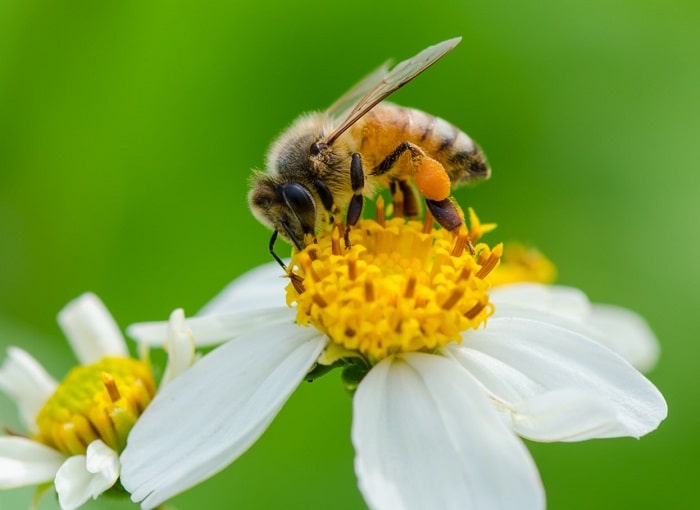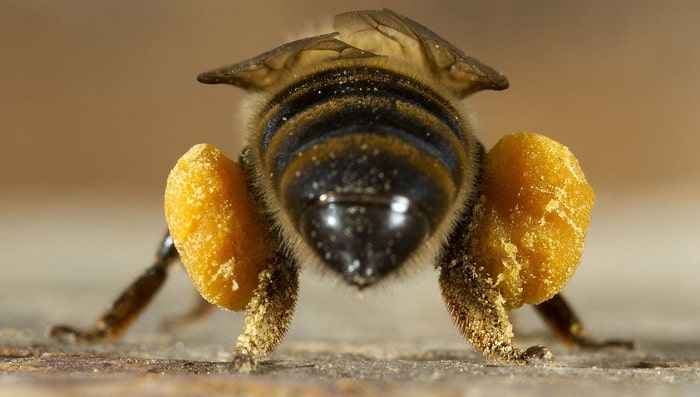Bee pollen is a valuable commodity with numerous applications. It is picked when the blossoms are still plentiful and fed to bees during difficult months such as winter. Harvested pollen can also be used to increase brood production because it is high in protein.
Pollen is becoming increasingly popular among humans. They are similar to superfoods, commanding a premium in various marketplaces throughout the world. They are high in nutrients such as proteins, enzymes, antioxidants, and many more. You can find bee pollen at health food stores. In this article, we will show you how to collect pollen from bees.
Why do bees need pollen?
What do bees make of pollen? We know that honey bees make honey from plant nectar. They do, however, gather pollen. Because it is a vital protein source required for colony survival. Pollen plays an equally crucial part in bee colony life as honey. Pollen is required for the development of new bees.
Plant pollen is the only source of protein for honey bees. They do not consume other insects like wasps and hornets. Without protein, no baby bees can be raised, and the colony will perish.
The demand for pollen is determined by the number of broods in the bee colony. The requirement for pollen rises as the brood size increases. Worker bees in colonies without Queens also collect pollen as a precaution against the parent bee.
The absence of pollen in a bee colony has a negative impact on the colony’s strength. Brood raised on low-quality pollen will be feeble and have a shorter life span. In severe circumstances, pollen-deprived colonies are unable to produce a brood.

How to harvest with a pollen trap?
Beekeepers use pollen traps to capture pollen. These are specially designed traps at the entrance of the hive. As bees approach the hive, pollen is delicately scraped off their feet. You will also have an extra portion of pollen on a separate tray or collection tray placed under the hive.
Honey bees fly and feed more as a result of pollen harvesting. A single swarm of bees may harvest between 50 and 250 grams of honey per day, according to estimates. This equates to around 1 to 7 kilos every year.
It is also worth noting that pollen quality varies according to location, meteorological circumstances, plant kind, bee type, and soil type. They also differ in terms of weight, color, size, and shape. Pollen contains about 200 compounds and is high in protein, accounting for 22.7 percent of the total.
How to process bee pollen?
When it comes to pollen, quality control is crucial. Unlike raw honey, this product is susceptible to deterioration caused by bacteria, molds, and fungi. Disposal begins immediately after collection as the product will deteriorate over time. This process goes through three stages: Drying, cleaning and storage.
-
How to dry bee pollen
To avoid mold growth and deterioration, it is critical to dry the pollen. Pollen used in beekeeping should be refrigerated rather than dry soon after gathering. The moisture content of the newly gathered pollen will range from 7 to 21%. It is best to keep the humidity level in the storage area between 2.5 and 6%.
You can use air drying to reduce the moisture in the pollen. Spread pollen evenly on the trays to a depth of 20 mm, then leave the tray in a sheltered place and away from direct sunlight and bumblebees. Pollen requires warm, dry air that is roughly 45 degrees Celsius.
-
How to clean bee pollen
After the pollen has dried up to around 6%, you should clean it. This will aid in the removal of foreign substances.
When cleaning pollen, you will need a variety of hand sieves. To begin, use a tiny fiberglass mesh as a sieve to separate dust from pollen. You will then pass the pollen through two 3 mm sieves to remove larger debris.
When cleaning up pollen, you can also employ gravity. The gravity screening system can capture large amounts of waste and each with its own collection box. The dust collects on the bottom screen.
-
How to preserve bee pollen?
The market standard for human pollen will take flavor and appearance into account. Creamy, even hue and bright yellow powder are in high demand on the market. The bitter flavor is unappealing.
You should store pollen in a clean, airtight container after processing. It is hygroscopic, which means that when exposed to air, it absorbs moisture. This will eventually have an impact on its quality. You also freeze it for 24 to 48 hours. This will aid in the prevention of bug infestation.

>>> Read more: Review of the VIVO BEE-V002 Large 2 Frame Honey Extractor
Uses of bee pollen
Bee pollen offers a wide range of applications. It is widely available in a variety of forms. Some of the most common applications for bee pollen include:
-
Helps reduce cholesterol
Studies have shown the positive benefits of pollen when it comes to cholesterol levels in the body. The study discovered that mice administered bee pollen had the lowest risk of developing atherosclerosis. Human investigations, on the other hand, have yet to confirm the same.
-
Anti-inflammatory
Pollen from bees is high in phenolic acids and flavonoids. These substances boost significant antioxidant qualities, which aid in the blocking of inflammatory enzymes in the body. Studies have shown that bee pollen can reduce inflammation by up to 75%.
-
Beneficial nutrients
Bee pollen contains a variety of elements that are beneficial to the body, including enzymes, vitamins, amino acids, and minerals. They are also the most complete protein source. The proteins are available as free amino acids, ready for absorption and usage right away. It has more amino acids than other meals, such as eggs, steak, and cheese. Certain nutrients, such as flavonoids, contribute to promoting blood vessel health and blood sugar regulation.
-
Reduce allergies
This is most likely the most common application for bee pollen. Medicines aid in the treatment of seasonal allergies by decreasing the body’s sensitivity to certain allergens. Bee pollen contains components of common allergens, which stimulate the creation of antibodies to combat allergic reactions.
-
Removes harmful radicals
Bee pollen’s health antioxidants aid in the battle against free radicals, which damage bodily cells. These free radicals are to blame for chronic diseases such as cancer. It is important to note that antioxidant levels vary depending on the plant source.

-
Liver health
Bee pollen is beneficial for liver health. It is high in antioxidants, which aids in the removal of harmful pollutants from the body. This, in turn, helps to keep the liver healthy, allowing for speedier repair to damaged livers.
-
Dietary supplements
One of the best dietary supplements is bee pollen. It enhances reproductive health, increases muscle growth, and aids in the body’s metabolism. Overall, bee pollen can not only improve overall health but also increase longevity.
-
Reduce stress
The fact that bee pollen aids in blood circulation throughout the body, particularly the nervous system, aids in stress reduction. This also aids in the elimination of exhaustion by distributing energy throughout the body. Several studies have shown that pollen is significantly beneficial for menopause. Patients who consumed bee pollen experienced fewer menopausal symptoms than those who did not.
Conclusion
You can use pollen for many applications. Most beekeepers gather and sell it to supplement their income. You can harvest pollen from honey bee colonies using pollen traps. When harvesting pollen for human consumption, it is also critical to ensure optimal hygiene.
Pollen is common in a number of industries. During difficult seasons, it also serves as a supplement for bees. Other commercial uses of pollen include plant feeding programs, allergy therapy, component extraction, and fruit pollination.
Related Posts:
